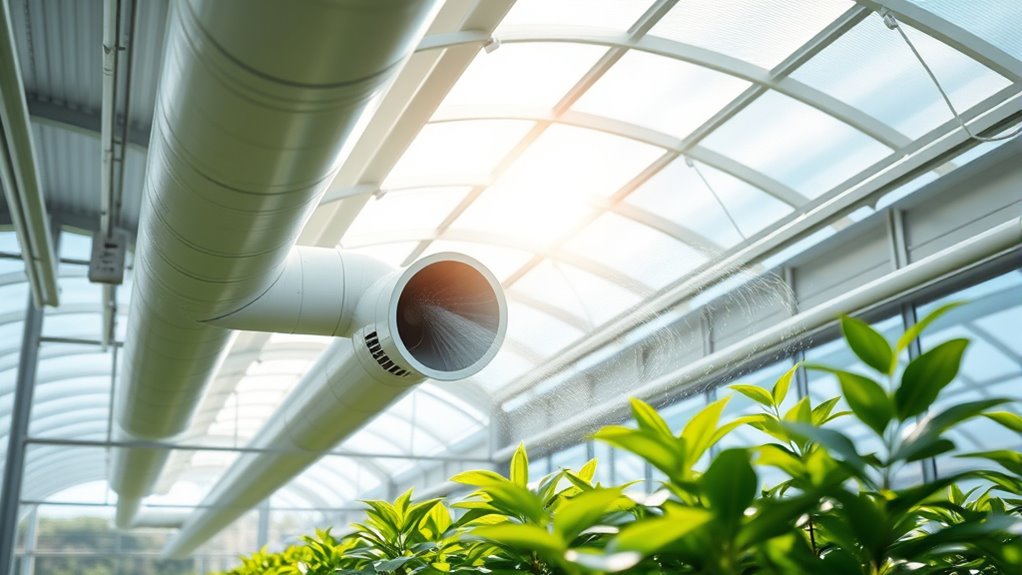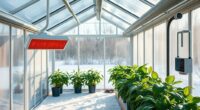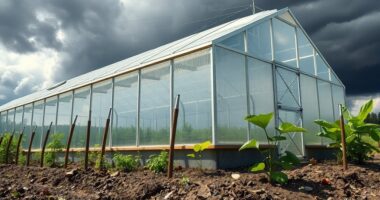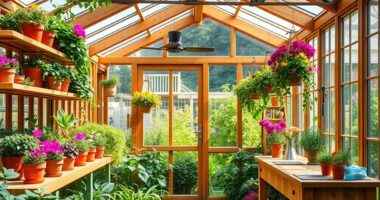To plan effective airflow for healthy plants, guarantee your ventilation system facilitates continuous exchange between indoor and outdoor air. Properly sized vents, exhaust fans, and intake filters help control humidity, remove odors, and prevent mold or pests. Balance air movement to avoid drafts or dryness that can stress plants. Incorporating adjustable systems keeps conditions ideal for growth. Keep reading to discover key tips for designing a ventilation setup that promotes vibrant, healthy plants.
Key Takeaways
- Ensure continuous air exchange to remove stale air, pollutants, and excess humidity, promoting healthy plant growth.
- Use properly sized vents, exhaust fans, and filters to balance airflow and prevent drafts or over-drying.
- Incorporate filtration to remove odors, pests, and airborne contaminants, maintaining optimal air quality.
- Adjust ventilation based on seasonal or environmental needs to prevent stress and maintain ideal conditions.
- Monitor and control humidity and airflow to prevent mold, pests, and diseases, supporting overall plant health.
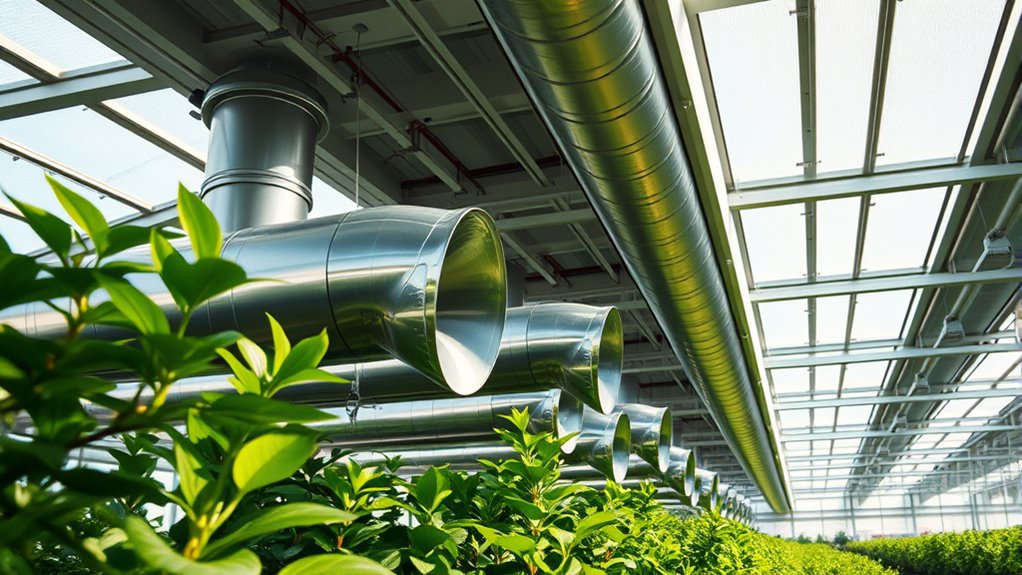
Have you ever wondered how fresh air circulates inside buildings or why proper ventilation is vital for your health? The answer lies in understanding how air exchange works. Effective ventilation systems facilitate the continuous movement of air, replacing stale indoor air with fresh outdoor air. This process is essential not just for comfort but also for maintaining healthy indoor environments. When air exchange is efficient, it prevents the buildup of pollutants, allergens, and excess humidity, all of which can compromise your health and the health of your plants. Proper airflow ensures that fresh air reaches every corner of a space, reducing the risk of mold growth and airborne contaminants that could cause respiratory issues or other health problems.
In addition to health benefits, good ventilation plays a significant role in odor control. Indoor spaces often accumulate odors from cooking, pets, plants, or even building materials. Without proper airflow, these odors linger, creating an unpleasant environment. A well-designed ventilation system helps to remove these smells quickly by constantly replacing contaminated indoor air with fresh air from outside. This not only improves the overall comfort of your space but also helps to maintain a neutral, clean scent that’s more welcoming. For plant environments, odor control is particularly important because it prevents the buildup of musty or organic smells that could indicate poor air quality or excessive humidity, both of which can harm plant health.
When planning your ventilation system, consider the balance between air exchange and odor control. You want enough airflow to keep air fresh and odors at bay but not so much that it causes drafts or over-drying, which can stress plants and occupants alike. Properly sized vents, exhaust fans, and intake filters work together to regulate this balance. For example, in a greenhouse or indoor garden, a controlled exhaust system can remove excess humidity and odors while bringing in fresh air. This constant exchange maintains ideal conditions for plant growth, preventing issues like mold, pests, or disease caused by stagnant, poorly ventilated air. Additionally, selecting ventilation systems with adjustable settings can optimize airflow according to seasonal or environmental needs. In regions with high outdoor pollution levels, integrating air filtration components into your system can further enhance indoor air quality and protect your plants.
Frequently Asked Questions
How Do I Choose the Right Ventilation System for My Plant Type?
When choosing the right ventilation system, you should consider your plant species and their airflow needs. Think about how much air circulation each plant requires to prevent mold and guarantee healthy growth. For delicate plants, opt for gentle airflow, while larger or more vigorous species may need stronger ventilation. Assess your space, plant type, and environmental conditions to select a system that provides ideal airflow for thriving plants.
What Are the Signs of Poor Airflow in a Grow Space?
Poor airflow is like a clogged artery—your plants struggle to breathe. Signs include stunted growth, wilting, or yellowing leaves. You might notice excess humidity, which invites mold and pests, increasing plant stress. A lack of fresh air circulation can cause musty smells and hot spots. Regularly check for these issues; proper airflow is essential for mold prevention and keeping your plants healthy and thriving.
How Often Should Ventilation Systems Be Maintained or Cleaned?
You should maintain your ventilation system regularly, ideally every 3 to 6 months. During this time, perform a system inspection to check for any issues, clean fans, and replace filters as needed. Filter replacement guarantees peak airflow and air quality, while system inspection helps catch problems early. Consistent maintenance keeps your grow space healthy, preventing mold and pests, and ensures your plants get fresh, properly circulated air.
Can Ventilation Systems Help Control Humidity Levels?
Yes, ventilation systems can help control humidity levels effectively. By improving air circulation, they prevent excess moisture buildup that can lead to mold and pests. Properly designed ventilation allows you to regulate humidity, maintaining ideal conditions for healthy plants. Regularly adjusting and maintaining your ventilation system ensures consistent humidity regulation, creating a stable environment that promotes plant growth and reduces disease risks.
What Is the Ideal Airflow Rate for Healthy Plant Growth?
While precise airflow rates vary, you need a balanced approach to support healthy plant growth. Too little air exchange stifles growth, causing humidity and disease issues; too much disrupts temperature and moisture levels. Ideal airflow dynamics depend on plant size and environment, but generally, you should aim for a rate that ensures consistent oxygen supply and carbon dioxide removal. Adjusting airflow to match plant needs fosters healthy growth and prevents stress.
Conclusion
Now that you understand how to plan your ventilation system, you hold the key to a thriving greenhouse. Think of airflow as the lifeblood that keeps your plants dancing happily in a gentle breeze. When you master proper ventilation, you create a symphony of fresh air and healthy growth. So, don’t let your garden breathe in chaos—design your airflow with care, and watch your plants flourish like a garden in full bloom under a clear sky.
